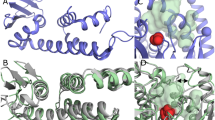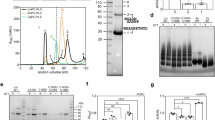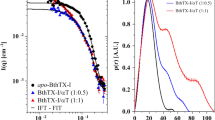Abstract
The 85–kD cytosolic phospholipase A2 (cPLA2) is a novel receptor–regulated phospholipase that is thought to initiate the production of inflammatory lipid mediators. Since cPLA2 is present only in minute amounts (less than 0.01% of total cellular protein) in various cells and tissues, we have used the baculovirus expression system to produce sufficient quantities of cPLA2 for structural and functional analysis. The cDNA for cPLA2 was cloned into a baculovirus expression vector and, upon infection of Spodoptera frugiperda Sf–21 cells with the recombinant virus, cPLA2 was produced at high levels (9% of total cellular soluble protein). Gel electrophoresis and immunoblot analysis demonstrated that the recombinant protein has properties indistinguishable from cPLA2 present in human monocytic U937 cells. Structural analysis of recombinant cPLA2, using electrospray mass spectrometry in conjunction with automated sequence analysis, confirmed the expected sequence and revealed two post–translational modifications of the protein, phosphorylation on at least one site, and acetylation of the N–terminal serine residue after removal of the initiating methionine. In spite of the presence of six potential N–glycosylation sites, there is no evidence that any of them is glycosylated. The baculovirus expression system should prove useful for production of cPLA2, and electrospray mass spectrometry is a rapid and accurate method for the analysis of post–translational modifications.
This is a preview of subscription content, access via your institution
Access options
Subscribe to this journal
Receive 12 print issues and online access
$209.00 per year
only $17.42 per issue
Buy this article
- Purchase on Springer Link
- Instant access to full article PDF
Prices may be subject to local taxes which are calculated during checkout
Similar content being viewed by others
References
Fenn, J. B., Mann, M., Meng, C.K., Wong, S.F. and Whitehouse, C.M. 1989. Science 246: 64–71.
Waite, M. 1987. The phospholipases. In: Handbook of Lipid Research, No. 5. Hanahan, D.J. (Ed.). Plenum Publishing Corp., New York.
Larsen, G.L. and Henson, P.M. 1983. Mediators of inflammation. Ann. Rev. Immunol. 1: 335–339.
Chang, J., Musser, J.H. and McGregor, H. 1987. Phospholipase A2: function and pharmacological regulation. Biochem. Pharmacol. 36: 2429–2436.
Clark, J.D., Milona, N. and Knopf, J.L. 1990. Purification of a 110-kiloDalton cytosolic phospholipase A2 from the human monocytic cell line U937. Proc. Natl. Acad. Sci. USA 87: 7708–7712.
Clark, J.D., Lin, L.-L., Kriz, R.W., Ramesha, C.S., Sultzman, L.A., Lin, A.Y., Milona, N. and Knopf, J.L. 1991. A novel arachidonic acid-selective cytosolic PLA2 contains a Ca2+-dependent translocation domain with homology to PKC and GAP. Cell 65: 1043–1051.
Kramer, R.M., Roberts, E.F., Manetta, J. and Putnam, J.E. 1991. The Ca2+-sensitive cytosolic phospholipase A2 is a 100-kDa protein in human monoblast U937 cells. J. Biol. Chem. 266: 5628–5272.
Sharp, J.D., White, D.L., Chiou, X.G., Goodson, T., Gamboa, G.C., McClure, D., Burgett, S., Hoskins, J., Skatrud, P.L., Sportsman, J.R., Becker, G.W., Kang, L.H., Roberts, E.F. and Kramer, R.M. 1991. Molecular cloning and expression of human Ca2+-sensitive cytosolic phospholipase A2 . J. Biol Chem. 266: 14850–14853.
Lin, L.-L., Lin, A.Y. and Knopf, J.L. 1992. Cytosolic phospholipase A2 is coupled to hormonally regulated release of arachidonic acid. Proc. Natl. Acad. Sci. USA 89: 6147–6151.
Luckow, V.A. 1991. Cloning and expression of heterologous genes in insect cells with baculovirus vectors, p. 97–152. In: Recombinant DNA Technology and Applications. Prokop, A., Bajpal, R.K., and Ho, C.S. (Eds.). McGrawHill, Inc., New York.
O'Rielly, D.R., Miller, L.K. and Luckow, V.A. 1992. Baculovirus Expression Vectors: A Laboratory Manual. W. H. Freeman and Company, New York.
Gibson, B.W. and Cohen, P. 1990. Liquid secondary ion mass spectrometry of phosphorylated and sulfated peptides and proteins. Methods in Enzymol. 193: 480–501.
Gibson, B.W. and Biemann, K. 1984. Strategy for the mass spectrometric verification and correction of the primary structures of proteins deduced from their DNA sequences. Proc. Natl. Acad. Sci. USA 81: 1956–1960.
Biemann, K. 1988. Contributions of mass spectrometry to peptide and protein structure. Biomed. Environ. Mass Spectrom. 16: 99–111.
Carr, S.A., Hemling, M.E., Bean, M.F. and Roberts, G.D. 1991. Integration of mass spectrometry in analytical biotechnology. Anal. Chem. 63: 2802–2824.
Ling, V., Guzzetta, A.W., Canova-Davis, E., Stults, J.T., Hancock, W.S., Covey, T.R. and Shushan, B.I. 1991. Characterization of the tryptic map of recombinant DNA derived tissue plasminogen activator by high-performance liquid chromatography-electrospray ionization mass spectrometry. Anal. Chem. 63: 2909–2915.
Biemann, K. 1992. Mass spectrometry of peptides and proteins. Annu. Rev. Biochem. 61: 977–1010.
Luckow, V.A. 1993. (In press) Protein Production and Processing from Baculovirus Expression Vectors. In: Insect Cell Cultures: Biopesticide and Protein Production, Shuler, M.L., Granados, R.R., Hammer, D.A. and Wood, H.A. (Eds.). Carl Hanser Verlag, Berlin.
Pelech, S.L. and Sanghera, J.S. 1992. Mitogen-activated protein kinases: versatile transducers for cell signaling. TIBS 17: 233–238.
Kemp, B.E. and Pearson, R.B. 1990. Protein kinase recognition sequence motifs. TIBS 15: 342–346.
Nemenoff, R.A., Winitz, S., Quian, N.-X., Van Putten, V., Johnson, G.L. and Heasley, L.E. 1993. Phosphorylation and activation of a high molecular weight form of phospholipase A2 by p42 microtubule-associated protein 2 kinase and protein kinase C. J. Biol. Chem. 268: 1960–1964.
Lin, L.-L., Wartmann, M., Lin, A.Y., Knopf, J.L., Seth, A. and Davis, R.J. 1993. cPLA2 is phosphorylated and activated by MAP kinase. Cell 72: 269–278.
Driessen, H.P., de Jong, W.W., Tesser, G.I. and Blomendal, H. 1985. The mechanism of N-terminal acetylation of proteins. CRC Crit. Rev. Biochem. 18: 281–325.
Nishimura, C., Yamaoka, T., Mizutani, M., Yamashita, K., Akera, T. and Tanimoto, T. 1991. Purification and characterization of the recombinant human aldose reductase expressed in baculovirus system. Biochim. et Biophys. Acta. 1078: 171–178.
Webb, N.R. and Summers, M.D. 1990. Expression of proteins using recombinant baculoviruses. Technique 2: 173–188.
Laemmli, U.K. 1970. Cleavage of structural proteins during the assembly of the head of bacteriophage T4. Nature 227: 680–685.
Author information
Authors and Affiliations
Rights and permissions
About this article
Cite this article
Becker, G., Miller, J., Kovacevic, S. et al. Characterization by Electrospray Mass Spectrometry of Human Ca2+–sensitive Cytosolic Phospholipase A2 Produced in Baculovirus–infected Insect Cells. Nat Biotechnol 12, 69–74 (1994). https://doi.org/10.1038/nbt0194-69
Received:
Accepted:
Issue Date:
DOI: https://doi.org/10.1038/nbt0194-69
This article is cited by
-
A new Trichoplusia ni cell line for membrane protein expression using a baculovirus expression vector system
In Vitro Cellular & Developmental Biology - Animal (2008)



